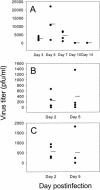Inability to evoke a long-lasting protective immune response to respiratory syncytial virus infection in mice correlates with ineffective nasal antibody responses
- PMID: 14557616
- PMCID: PMC229280
- DOI: 10.1128/jvi.77.21.11303-11311.2003
Inability to evoke a long-lasting protective immune response to respiratory syncytial virus infection in mice correlates with ineffective nasal antibody responses
Abstract
Long-lasting protective antibody is not normally generated in children following primary respiratory syncytial virus (RSV) infection, frequently leading to reinfection. We used the BALB/c mouse model to examine the role of the nasal-associated lymphoid tissue and the bone marrow in the generation of RSV-specific long-lasting plasma cells, with a view to further understanding the mechanisms responsible for the poorly sustained RSV antibody levels following primary infection. We show here that substantial numbers of RSV-specific plasma cells were generated in the bone marrow following challenge, which were maintained thereafter. In contrast, in the nasal-associated lymphoid tissue, RSV-specific plasma cell numbers waned quickly both after primary infection and after challenge and were not maintained at a higher level after boosting. These data indicate that the inability to generate a robust local mucosal response in the nasal tissues may contribute substantially to the likelihood of subsequent reinfection and that the presence of serum anti-RSV antibody without local protection is not enough to protect against reinfection.
Figures





Similar articles
-
Enhancement of mucosal and cellular immune response in mice by vaccination with respiratory syncytial virus DNA encapsulated with transfersome.Viral Immunol. 2008 Dec;21(4):483-9. doi: 10.1089/vim.2008.0044. Viral Immunol. 2008. PMID: 19115938
-
Formulation of the respiratory syncytial virus fusion protein with a polymer-based combination adjuvant promotes transient and local innate immune responses and leads to improved adaptive immunity.Vaccine. 2016 Sep 30;34(42):5114-5124. doi: 10.1016/j.vaccine.2016.08.053. Epub 2016 Aug 31. Vaccine. 2016. PMID: 27591951
-
A Single-Dose Recombinant Parainfluenza Virus 5-Vectored Vaccine Expressing Respiratory Syncytial Virus (RSV) F or G Protein Protected Cotton Rats and African Green Monkeys from RSV Challenge.J Virol. 2017 May 12;91(11):e00066-17. doi: 10.1128/JVI.00066-17. Print 2017 Jun 1. J Virol. 2017. PMID: 28298602 Free PMC article.
-
Immune responses and disease enhancement during respiratory syncytial virus infection.Clin Microbiol Rev. 2005 Jul;18(3):541-55. doi: 10.1128/CMR.18.3.541-555.2005. Clin Microbiol Rev. 2005. PMID: 16020689 Free PMC article. Review.
-
Early-Life Respiratory Syncytial Virus Infection, Trained Immunity and Subsequent Pulmonary Diseases.Viruses. 2020 May 4;12(5):505. doi: 10.3390/v12050505. Viruses. 2020. PMID: 32375305 Free PMC article. Review.
Cited by
-
Lessons for COVID-19 Immunity from Other Coronavirus Infections.Immunity. 2020 Aug 18;53(2):248-263. doi: 10.1016/j.immuni.2020.07.005. Epub 2020 Jul 14. Immunity. 2020. PMID: 32717182 Free PMC article. Review.
-
Staphylococcus aureus-specific IgA antibody in milk suppresses the multiplication of S. aureus in infected bovine udder.BMC Vet Res. 2019 Aug 9;15(1):286. doi: 10.1186/s12917-019-2025-3. BMC Vet Res. 2019. PMID: 31399125 Free PMC article.
-
Respiratory syncytial virus engineered to express the cystic fibrosis transmembrane conductance regulator corrects the bioelectric phenotype of human cystic fibrosis airway epithelium in vitro.J Virol. 2010 Aug;84(15):7770-81. doi: 10.1128/JVI.00346-10. Epub 2010 May 26. J Virol. 2010. PMID: 20504917 Free PMC article.
-
Role of Type I Interferon (IFN) in the Respiratory Syncytial Virus (RSV) Immune Response and Disease Severity.Front Immunol. 2019 Mar 26;10:566. doi: 10.3389/fimmu.2019.00566. eCollection 2019. Front Immunol. 2019. PMID: 30972063 Free PMC article. Review.
-
Mucosal vaccines against respiratory syncytial virus.Curr Opin Virol. 2014 Jun;6:78-84. doi: 10.1016/j.coviro.2014.03.009. Epub 2014 Apr 29. Curr Opin Virol. 2014. PMID: 24794644 Free PMC article. Review.
References
-
- Asanuma, H., A. H. Thompson, T. Iwasaki, Y. Sato, Y. Inaba, C. Aizawa, T. Kurata, and S. Tamura. 1997. Isolation and characterization of mouse nasal-associated lymphoid tissue. J. Immunol. Methods 202:123-131. - PubMed
-
- Brandenburg, A. H., J. Groen, H. A. van Steensel-Moll, E. C. Claas, P. H. Rothbarth, H. J. Neijens, and A. D. Osterhaus. 1997. Respiratory syncytial virus specific serum antibodies in infants under six months of age: limited serological response upon infection. J. Med. Virol. 52:97-104. - PubMed
-
- Chang, J., and T. J. Braciale. 2002. Respiratory syncytial virus infection suppresses lung CD8+ T-cell effector activity and peripheral CD8+ T-cell memory in the respiratory tract. Nat. Med. 8:54-60. - PubMed
-
- Crowe, J. E., Jr. 2001. Influence of maternal antibodies on neonatal immunization against respiratory viruses. Clin. Infect. Dis. 33:1720-1727. - PubMed
-
- Crowe, J. E., Jr. 1998. Immune responses of infants to infection with respiratory viruses and live attenuated respiratory virus candidate vaccines. Vaccine 16:1423-1432. - PubMed
Publication types
MeSH terms
Substances
LinkOut - more resources
Full Text Sources
Medical

